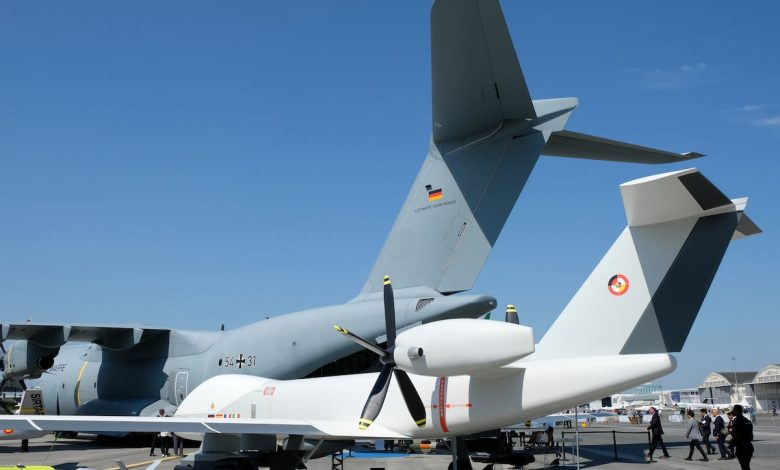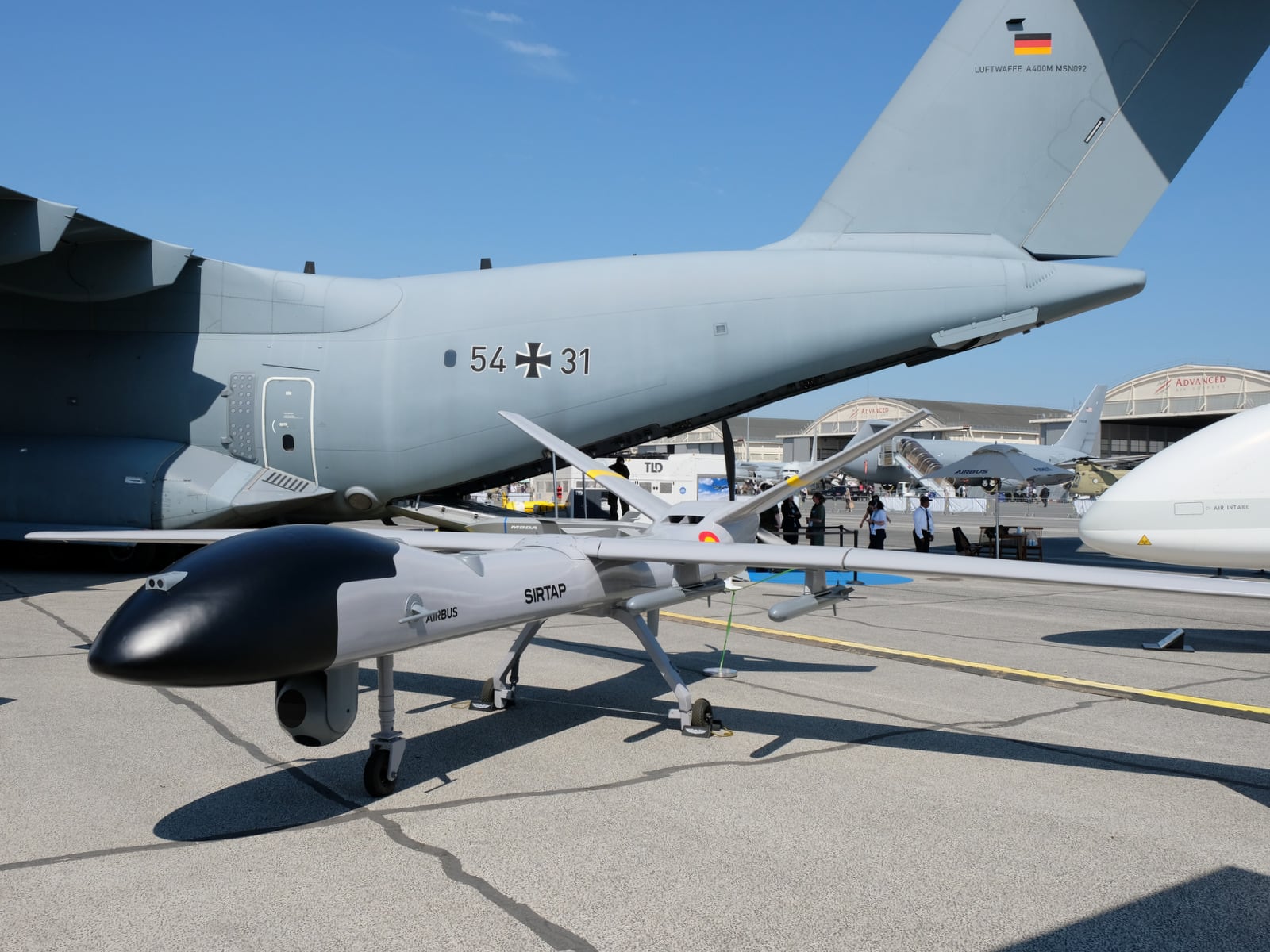France gauges a new crop of MALE drones for surveillance, strike

PARIS — France asked five local companies to develop demonstrators for a medium-altitude, long-endurance drone, signing contracts at the Paris Air Show this week as the country seeks a low-cost solution to plug a capability gap in unmanned aerial surveillance and light attack.
France’s Directorate General for Armament will subsidize work by aircraft makers Aura Aero, Daher and SE Aviation, drone maker Fly-R and aerospace company Turgis Gaillard to produce competing MALE drone demonstrators as early as 2026, the agency said June 18.
The market for MALE drones is evolving rapidly as the war in Ukraine shows their effectiveness as well as limitations. Meanwhile, the number of offerings of affordable platforms is growing, with countries such as France and Turkey focusing on developing domestic capabilities in the area. Companies at this year’s air show presented more than a dozen MALE drones at various stages of development.
“These initiatives are part of an effort to adapt military capabilities to meet evolving threats,” DGA said in a statement, saying the drones “play an essential role in modern conflict zones.”
The agency said recent high-intensity conflicts had highlighted the need for drones with long endurance at medium altitude, but also low cost, capable of performing multiple missions, resistant to jamming and which can be deployed rapidly. MALE drones are typically used for reconnaissance, surveillance and intelligence, and light attack roles.
The agreements mark “a decisive step in accelerating the MALE drone strategy of the Armed Forces Ministry,” the DGA statement reads. “They will make it possible to create the best operational solution while respecting time and cost constraints.”
Delays with the Eurodrone MALE drone being developed by Airbus, Dassault Aviation and Leonardo have forced countries including France and Germany to rely on foreign alternatives such as the MQ-9 Reaper by General Atomics and the IAI Heron from Israel Aerospace Industries, while also causing ballooning costs and a risk of technical obsolescence for the program.
The DGA said the signed demonstrator contracts will add options and create export opportunities and signal its commitment to creating a competitive MALE drone industry that will benefit the French armed forces. The initial budget is modest, with the DGA providing around €10 million ($12 million) in total for the five projects, company representatives told Defense News.
The five companies are offering rather different drones under the MALE label, in terms of size, payload, cost as well as endurance.
Turgis Gaillard presented its Aarok drone at the Paris Air Show, with a wingspan of 22 meters, endurance of more than 20 hours, a weapons payload of 1 metric ton, and a price tag the company told Defense News will be somewhere between €10 million and €30 million. The company has completed high-speed roll tests and plans the first flight of the drone by the end of the year.
Meanwhile, SE Aviation showcased its Driade drone, derived from its MCR 4S kit aircraft, which has a wingspan of around 8.7 meters. The drone will have a payload of 470 kilograms as well as 36 hours of endurance in a reconnaissance configuration, according to the company.
With Driade based on an existing certified aircraft, SE Aviation will be able to test autonomous flight this year, and the drone will have a price tag of less than €5 million, company CEO and co-founder Eric Fumey told Defense News.
Fumey said it’s unclear for now how many drone projects the DGA plans to retain for a second phase, saying that will depend on whether the directorate aims for different drones for different missions, “or one drone that does it all.”
French aircraft maker Aura Aero will develop its MALE drone Enbata under the DGA contract, while Fly-R signed with the DGA for its R2-600 MALE drone, notable for its rhomboidal wing, a joined wing configuration in a hollow diamond shape, and a maximum payload of 600 kilometers and endurance of 25 hours.
For aircraft maker Daher, the drone project is part of a wider push to expand its defense business, company executives said at a press briefing here on Wednesday.
It’s up to the company to show its aircraft can be “dronized,” and Draher may have an advantage to get its drone flying because the model will be based on an existing, certified plane which the company knows how to build, CEO Didier Kayat said.
The priority of the DGA is cost, followed by time to delivery, and Daher plans to test an unmanned aircraft by the end of 2025, according to Pascal Laguerre, the firm’s head of new technologies. The DGA contract will cover about 25% of the costs to prepare the demonstrator, with Daher financing the remainder in order “to play in this arena,” Laguerre said.
For Daher to double defense sales to €600 million euros over the next three to five years should be relatively easy, Kayat said. The company’s defense business includes more than €100 million in revenue as a supplier to Boeing’s KC-46 Pegasus tanker program, according to the CEO.
Other MALE drones on show in Paris include the Bayraktar Akinci at the Leonardo stand, a mock up of the Aksungur drone by Turkish Aerospace Industries, as well as the long-serving MQ-9 Reaper produced by General Atomics, an evolution from the granddaddy of MALE drones, the MQ-1 Predator. Aviation Industry Corp. of China displayed models of several MALE drones in its Wing Loong range.
Safran presented its Patroller MALE drone used by the French Army, with a wingspan of 18 meters and a flight time of 14 hours.
Airbus showed a mock-up of the Eurodrone, a bigger aircraft than most of the competition with a wingspan of 30 meters and a 13-ton maximum takeoff weight, a 2.3-ton payload and an autonomy of 40 hours.

The aircraft is further away from fielding than some of the MALE drones on display at the Paris Air Show, as an infamous example of large-scale, multinational European defense cooperation running into complications and delays. The first prototype flight is now slated for mid-2027, from an original plan for entry into service by 2025.
Airbus at this time continues to target entry into service by the end of the decade, Jean-Brice Dumont, the company’s head of air power, said at a press conference here on Tuesday.
Airbus also presented a mock-up of its Sirtap drone developed for the Spanish armed forces, an unmanned aerial vehicle with a 12-meter wingspan and endurance of more than 20 hours that bridges the gap between light UAVs and heavier MALE systems. The drone is expected to fly this year, with delivery to the Spanish forces by the end of 2026 and certification the following year.
Rudy Ruitenberg is a Europe correspondent for Defense News. He started his career at Bloomberg News and has experience reporting on technology, commodity markets and politics.







